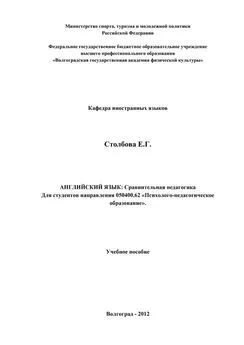Елена Беликова - Английский язык для медиков
- Название:Английский язык для медиков
- Автор:
- Жанр:
- Издательство:Конспекты, шпаргалки, учебники «ЭКСМО»b4455b31-6e46-102c-b0cc-edc40df1930e
- Год:2008
- Город:Москва
- ISBN:978-5-699-24046-3
- Рейтинг:
- Избранное:Добавить в избранное
-
Отзывы:
-
Ваша оценка:
Елена Беликова - Английский язык для медиков краткое содержание
Студенту без шпаргалки никуда! Удобное и красивое оформление, ответы на все экзаменационные вопросы ведущих вузов России.
Английский язык для медиков - читать онлайн бесплатно полную версию (весь текст целиком)
Интервал:
Закладка:
underlying – основной
lamina – тонкая пластинка
rich – богатый
elastin – эластин
loose – свободный
vessel – сосуд
lymphatics – лимфатический
defensive cells – защитные клетки
outer – внешний
edge – край
37. Respiratory bronchioles
Respiratory bronchioles are areas of transition (hybrids) between the conducting and respiratory portions of the airways. In addi tion to the typical bronchiolar epithelium of the terminal bron chioles, these passageways contain outpouchings of alveoli, which comprise the respiratory portion of this system.
Terminal bronchioles give rise to respiratory bronchioles.
Respiratory bronchioles branch to form two to three alveolar ducts, which are long sinuous tubes.
Alveolar sacs are spaces formed by two or more conjoined alveoli. They are lined by the simple squamous alveolar epithe lium. Alveoli are the terminal, thin—walled sacs of the respiratory tree that are responsible for gas exchange. There are approximately 300 million alveoli per lung, each one 200–300 mm in diameter. Blood—air interface. Oxygen in the alveoli is separated from hemoglobin in the red blood cells of alveolar capillaries by five layers of membrane and cells: the alveolar epithelial cell (api cal and basal membranes) and its basal lamina, the basal lami na of the capillary and its endothelial cell (basal and apical membranes), and the erythrocyte membrane. The total thick ness of all these layers can be as thin as 0,5 mm.
Alveolar epithelium contains two cell types. Type I cells completely cover the alveolar luminal surface and provide a thin surface for gas exchange. This simple squamous epithelium is so thin (-25 nm) that its details are beyond the resolution of the light microscope.
Type II cells are rounded, plump, cuboidal—like cells that sit on the basal lamina of the epithelium and contain mem brane—bound granules of phospholipid and protein (lamel lar bodies). The contents of these lamellar bodies are secreted onto the alveolar surface to provide a coating of surfactant that reduces alveolar surface tension.
Alveolar macrophages (dust cells) are found on the surface of the alveoli.
Derived from monocytes that extravasate from alveolar capillaries, alveotar macrophages are part of the mononu – clear phagocyte system. Dust cells, as their name implies, continuously remove parti cles and other irritants in the alveoli by phagocytosis.
New words
respiratory bronchioles – дыхательные бронхиолы
hybrids – гибриды
respiratory portions – дыхательные части
airways – воздушные трассы
bronchiolar – бронхиолярный
terminal bron chioles – предельные бронхиолы
passageway – проходы
tocomprise – включить
ducts – трубочки
sinuous tubes – извилистые трубы
thin—walled – окруженный тонкой стеной
sacs – мешочки
respiratory tree – дыхательное дерево
hemoglobin – гемоглобин
apical – апикальный
38. Pleura
Visceral pleura is a thin serous membrane that covers the outer surface of the lungs. A delicate connective tissue layer of collagen and elastin, containing lymphatic channels, vessels, and nerves, supports the membrane. Its surface is covered by simple squamous mesothelium with microvilli.
Parietal pleura is that portion of the pleura that continues onto the inner aspect of the thoracic wall. It is continuous with the visceral pleura and is lined by the same me—sothelium.
Pleural cavity is a very narrow fluid—filled space that contains monocytes located between the two pleural membranes. It contains no gases and becomes a true cavity only in disease (e. g., in pleural infection, fluid and pus may accumulate in the pleural space). If the chest wall is punctured, air may enter the pleural space (pneumotho—rax), breaking the vacuum, and allowing the lung to recoil. Parietal pleura lines the inner surface of the thoracic cavity; visceral pleura follows the contours of the lung itself.
Pleural cavity: The pleural cavity is the space between the parietal and viscer al layers of the pleura. It is a sealed, blind space. The introduc tion of air into the pleural cavity may cause the lung to col lapse (pneumothorax).
It normally contains a small amount of serous fluid elaborated by mesothelial cells of the pleural membrane.
Pleural reflections are areas where the pleura changes direction from one wall to the other. The sternal line of reflection is where the costal pleura is con tinuous with the mediastinal pleura behind the sternum (from costal cartilages 2–4). The pleural margin then passes inferiorly to the level of the sixth costal cartilage. The costal line of reflection is where the costal pleura becomes continuous with the diaphragmatic pleura from rib 8 in the mid—clavicular line, to rib 10 in the midaxillary line, and to rib 12 lateral to the vertebral column. Pleural recesses are potential spaces not occupied by lung tissue except during deep inspiration. Costodiaphragmatic recesses are spaces below the inferior borders of the lungs where costal and diaphragmatic pleura are in contact. Costomedia—stinal recess is a space where the left costal and mediasti—nal parietal pleura meet, leaving a space due to the cardiac notch of the left lung. This space is occupied by the lingu—la of the left lung during inspiration.
In nervation of the parietal pleura: The costal and peripheral portions of the diaphragmatic pleu ra are supplied by intercostal nerves.
The central portion of the diaphragmatic pleura and the medi astinal pleura are supplied by the phrenic nerve.
New words
visceral – висцеральный
pleura – плевра
dcollagen – коллаген
elastin – эластин
lymphatic channels – лимфатические сосуды
nerves – нервы
squamous – чешуйчатый
microvilli – микроворсинки
parietal pleura – париетальная плевра
visceral pleura – висцеральная плевра
costal – реберный
39. Nasal cavities
The anatomical structures that play a central role in the res piratory system are located in the head and neck as well as the thorax.
Nasal cavities are separated by the nasal septum, which consists of the vomer, the perpendicular plate of the ethmoid bone, and the septal cartilage. The lateral wall of each nasal cavity features three scroll—shaped bony structures called the nasal conchae. The nasal cavities communicate posteriorly with the nasopharynx through the choanae. The spaces inferior to each concha are called meatus. The paranasal sinu—ses and the nasolacrimal duct open to the meati. The inferior concha is a separate bone, and the superior and middle conchae are parts of the ethmoid bone.
Inferior meatus. The only structure that opens to the inferior meatus is the nasolacrimal duct. This duct drains lacrimal fluid (i. e., tears) from theTneaTaraspect of the orbit to the nasal cavity.
Middle meatus: the hiatus semilumaris contains openings of frontal and maxillary sinuses and americy ethmo—idal air cells. The bulla ethmoidalis contains the opening for'the middle ethmoidal air cells.
Superior meatus contains an opening for thff'posterior ethmoidal air cells.
Sphenoethmoidal recess is located above the superior concha and contains an opening for the sphenoid sinus.
Innervation: Somatic innervation. General sensory information from the lateral wall and septum of the nasal cavity is conveyed to the CNS by branches of V, and V2.
Autonomic innervation. Preganglionic parasympathetic fibers destined to supply the glands of the nasal mucosa and the lacrimal gland travel in the nervus intermedius and the greater superficial petrosal branches of the facial nerve (CN VII). These fibers synapse in the pte—rygopalatine ganglion, which is located in the pterygopa—latine fossa. Postganglionic fibers traveling to the mucous glands of the nasal cavity, paranasal air sinuses, hard and soft palate, and the lacrimal gland follow branches of V2 and in some cases V1, to reach their destinations.
New words
anatomical – анатомический
respiratory system – дыхательная система
head – голова
neck – шея
nasal cavities – носовые впадины
the perpendicular plate – перпендикулярная пластина
ethmoid – решетчатый
septal – относящийся к перегородке
nasal conchae – носовой раковина
paranasal – параносовой
sinuses – пазухи
nasolacrimal – назолакримальный
duct – трубочка
drain – проток
tears – слезы
orbit – орбита
maxillary – верхнечелюстной
bulla – булла
40. Pharynx and related areas
The pharynx is a passageway shared by the digestive and respira tory systems. It has lateral, posterior, and medial walls through out, but is open interiorly in its upper regions, communicating with the nasal cavity and the oral cavity. The anterior wall of the laryngopharynx is formed by the larynx. The pharyngeal wall con sists of a mucosa, a fibrous layer, and a muscularis, which is com posed of an inner longitudinal layer and an outer circular layer.
Nasopharynx is the region of the pharynx located directly poste rior to the nasal cavity. It communicates with the nasal cavity through the choanae.
The torus tubarius is the cartilaginous rim of the auditory The pharyngeal recess is the space located directly above and behind the torus tubarius; it contains the nasopharyn—geal tonsil. The salpingopharyngeal fold is a ridge consisting of mucosa and the underlying salpingopharyngeus muscle.
Oropharynx is the region of the pharynx located directly posterior to the oral cavity. It communicates with the oral cavity through a space called the fauces. The fauces are bounded by two folds, consisting of mucosa and muscle, known as the anterior and posterior pillars.
The tonsillar bed is the space between the pillars that houses the palatine tonsil.
Laryngopharynx is the region of the pharynx that surrounds the larynx. It extends from the tip of the epiglottis to the cricoid car tilage. Its lateral extensions are known as the piriform recess.
Oral cavity: the portion of the oral cavity that is posterior to the lips and anterior to the teeth is called the vestibule. The oral cavi ty proper has a floor formed by the mylohyo—id and geniohyoid muscles, which support the tongue. It has lateral walls, consisting of the buccinator muscles and buccal mucosa, and a roof formed by the hard palate an teriorly and the soft palate posteriorly. Its posterior wall is absent and is replaced by an opening to the oropharynx, which is flanked by the pillars of the fauces.
The palate separates the nasal and oral cavities.
Hard palate is formed by the palatine process of the maxilla and the horizontal palate of the palatine bone. Its mu—cosa is supplied with sensory fibers from CN V2.
Soft palate consists of a fibrous membrane, the palatine aponeurosis, covered with mucosa. The portion that hangs down in the midline is the uvula.
Читать дальшеИнтервал:
Закладка:










